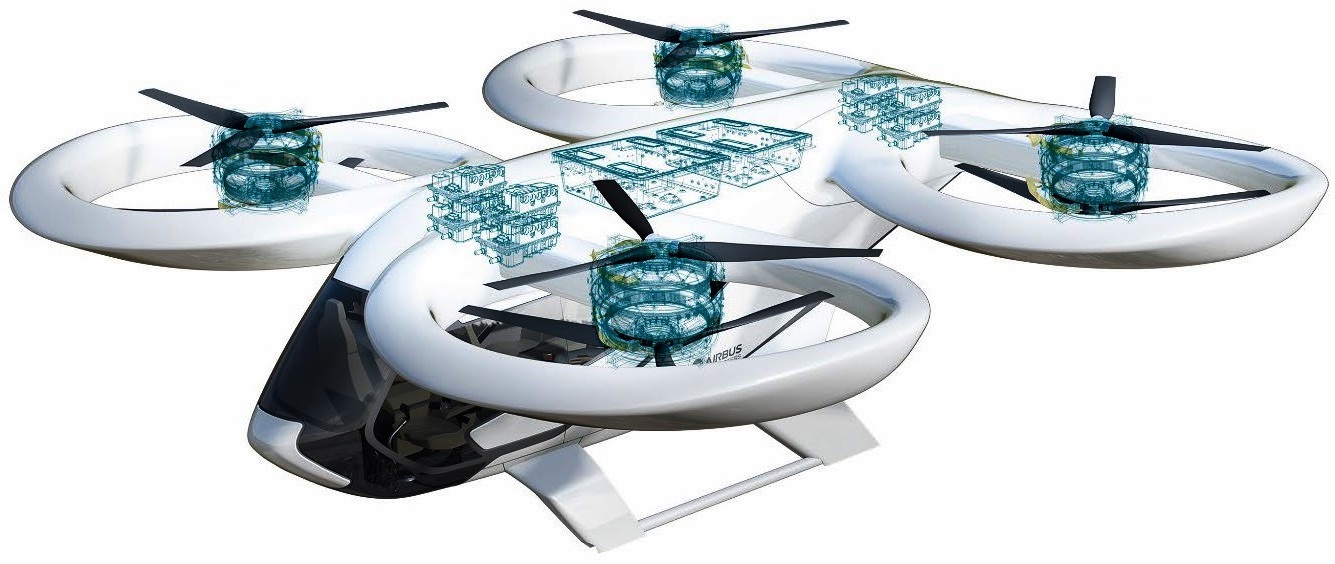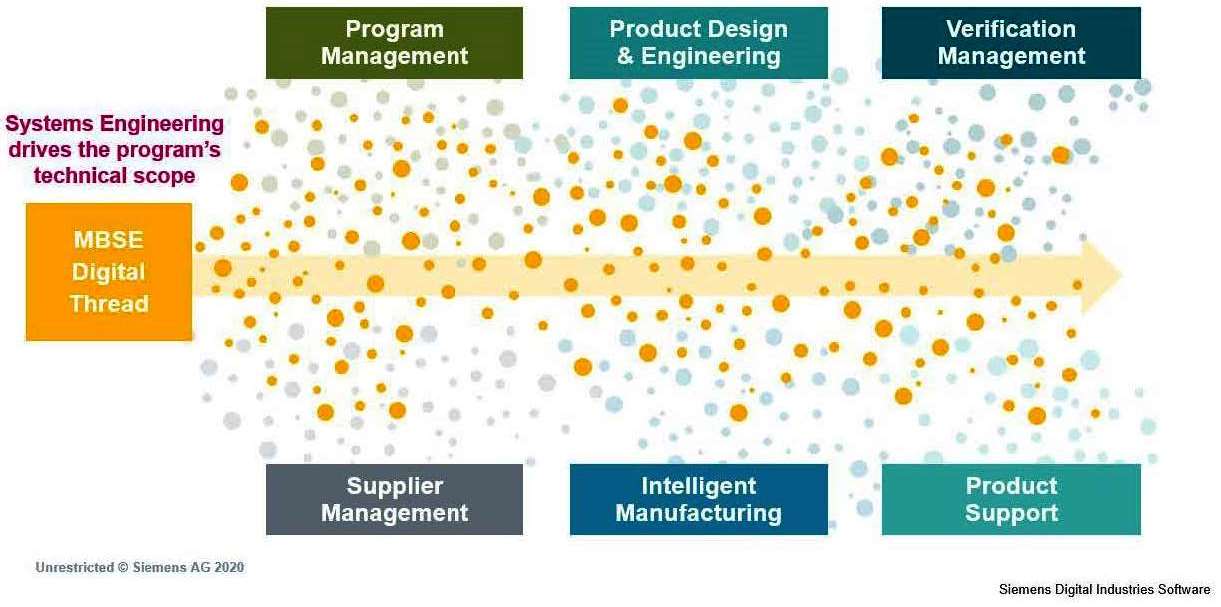Accelerating digital transformation and innovation in A&D via MBSE

Image courtesy Siemens
Innovation is the name of the game in the aerospace and defence (A&D) industry. In fact, innovation is leading the charge in the burgeoning urban air mobility (UAM) market, fueling new opportunities in propulsion (electric, hybrid-electric and hydrogen) and ushering in a new era of space travel and exploration.
No matter where you look, great ideas are emerging faster than ever. There is talk of new supersonic and hypersonic flight. Green solutions and new sustainability measures are also quickly emerging. Innovation is being fuelled by start-ups around the globe, as well as major players in both the commercial and defence sectors. For the world of engineering and product development, this means the pressure is on not only to innovate but also to get to market faster with safe and reliable products, all while reducing programme cost.
Dealing with complexity
The complexities that can hamper innovation are not going away. If anything, they are increasing by the day. In addition to the everyday complexities, there are new challenges on the horizon. We are seeing increased use of electrification throughout the aircraft. More efficient and reliable electromechanical options are supplanting hydraulic technologies. Electronics are replacing the more traditional mechanical functionality. Also, let us not forget that everything these days is driven by software and building more software functionality into an aircraft is on the rise as well. While it is true software enables greater control and flexibility, improved efficiencies and futuristic-type capabilities, it also makes the tasks of the engineering team a great deal more difficult.
Designing, validating, certifying and delivering an A&D product is a far more difficult proposition these days.
The interconnectedness of everything
Aerospace engineering executives around the world are looking for the latest methods to develop next-generation aircraft. Everything is interconnected and there is a lot more integration as development shifts to a system or systems of interconnected systems. A&D teams need a proven methodology that brings these products to market faster and in the process, capitalises on the growing demand for innovative and highly interconnected products. Model-Based Systems Engineering (MBSE), is that method – providing a digitalised solution that harnesses the complexity behind highly integrated systems, delivering superior products on time and within schedule.
Emergence of MBSE
Helping teams design and build these myriad integrated systems to communicate and collaborate more effectively is what MBSE is all about. MBSE is growing in popularity because it is a more modern approach to systems engineering. It brings a new level of integration and efficiency to complex systems and processes across the many multidomain challenges aircraft manufacturers use today. Some in the industry may already be familiar with MBSE methods. Others might be more familiar with 'systems engineering' or 'systems design' as these activities are common today. To understand the value behind MBSE, it is important to define these two terms (of course, there are a variety of definitions depending on who you ask.)
Systems engineering starts with the big picture and works its way down into the details. It is extremely rigorous about managing requirements and driving those requirements and functions down into systems, subsystems and components. Through this methodical process of driving requirements further down from one level to the next, it is possible to trace a requirement from the high-level view of an aircraft down to an integrated circuit and back again.
Systems design on the other hand is an interdisciplinary engineering activity that enables the realisation of a specific system. It is a type of process that defines components, interfaces and other data to ensure all specified requirements have been met. It is also an important way to focus on safety.
Companies that implement a systems engineering approach today, struggle when they rely on document-based solutions. One set of requirements might be in one database, system modelling might be in Microsoft Visio or SysML tools, system safety analysis might be in various tools and verification and test data might end up in an Excel spreadsheet.
Everything is disconnected and the deliverables look like a document. Further, much of this activity often occurs in isolated workspaces or silos. As new requirements and system models are produced to define larger, more complex systems, document-centric approaches do not scale and it is nearly impossible to manage traceability when you are trying to address tens or hundreds of thousands of interactions.
With MBSE, all processes throughout product development are supported by a comprehensive digital twin and digital thread workflows which tie decisions and data across domains. As a result, this 'single source of truth' makes data more readily accessible for the multidisciplinary development of today’s most advanced A&D products.
MBSE and the digital transformation
It is important to realise the MBSE approach is much more than functional or logical modelling. It is built as a digital thread (MBSE digital thread) and serves as the 'digital backbone' which unites engineering, manufacturing, supply chain and programme management activities (Figure 1). A digital thread is a composite of interwoven and interconnected digital strands, creating an ecosystem for programme execution excellence.

Figure 1:
The MBSE digital thread touches all key product development domains for complete
traceability and visibility.
The MBSE digital thread creates a model-based systems engineering process that connects multiple domains within the digital enterprise. Through the tight integration of this digital thread, teams from these domains can test, retest and push the boundaries virtually, optimising the product before building hardware to avoid jeopardising downstream work and timelines. When companies transition from system modelling to the MBSE approach, they are able to leverage an open ecosystem that enables the usage of any system modeling tool. They are connected to the entire lifecycle of data and information needed to certify, test, verify, deliver and maintain new products.
A robust, comprehensive MBSE digital thread enables companies and programmes to orchestrate their technical programme and manage their technical scope throughout the entire product lifecycle. This is significant because many of today’s products take several years to develop and aircraft OEMs need to establish a certain level of continuity.
MBSE acceptance within the industry
Increasingly, MBSE is gaining widespread usage as companies seek to certify more complex and highly integrated systems. The Federal Aviation Agency (FAA), the European Union Aviation Safety Agency (EASA) along with other regulatory agencies are requiring a more organised systems engineering approach for OEMs and their partners. The United States Department of Defense (DoD) also recognises the need for MBSE. The DoD sees MBSE as the means to communicate requirements more effectively to the OEMs and having a process in place to check that all requirements have been satisfied. A robust MBSE digital thread enables companies to accelerate their product development and certification processes, while improving communications with various regulatory agencies.
Is MBSE in your future?
The MBSE digital thread makes everything come together and function as a digital enterprise. It connects your requirements to your model, to your design, to your analysis and ultimately, to your verification processes and artifacts. Because you are automating these data hand-offs with a digital thread (not a printed document), you gain the convenience of full traceability. Collaboration and continuity of data occurs up and down the entire product lifecycle.
Zero-emissions aircraft
The zero-emissions aircraft offers a complex array of challenges as the aerospace and defence industry seeks to build a more sustainable future. The process to build zero-emissions aircraft includes the steepest hurdles. Until now, sustainability has focused primarily on CO2 emissions during aircraft operation and while this is an important area to address, attention also needs to be placed on the impact of material processing, manufacturing operations and how the aircraft will be maintained.
Significant developments already in operation
One way today’s OEMs are improving sustainability is by building greater efficiencies into the aircraft, which improves fuel economy and reduces fuel emissions. The Boeing 787 is a good example. The 787 is producing around 20% to 30% lower fuel burn on international flights. How? Boeing first improved overall aerodynamics which included modifying the wings. Boeing then incorporated lightweight structures (more composites) which also contributed to better overall fuel economies. Finally, Boeing transitioned to more electrically driven systems to improve the efficiency of the systems and reducing the power extraction from the engines.
Another approach to sustainability is sustainable aviation fuel (SAF) adoption. SAF has been implemented by commercial airlines around the world. Some companies have made strides through their own corporate mandates, whilst others are following government regulations based on that company’s country of origin. In fact, most airlines around the world have committed to replacing 10% of the jet fuel they consume with SAF by 2030.
Electrification of functionality throughout the aircraft is another contributor to a sustainable future. Boeing and Airbus have introduced a number of electrical systems (to replace mechanical or pneumatic systems) for improvements in performance, weight, efficiency and maintenance.
Also let us not forget the promise of the electric aircraft. Notable breakthroughs have occurred especially among regional carriers. The emergence of Heart Aerospace, Eviation and Bye Aerospace are testament to the validity behind the future of electric air travel. Of course, electric vertical take-off and landing (eVTOL) vehicles bring a new level of technology and excitement to the marketplace and this segment is expected to take off in the next two to three years.
Clean manufacturing
With the current sustainability efforts already underway, companies are also shifting their mindset to focus on clean manufacturing. Clean manufacturing is an approach that allows OEMs to eliminate waste and lower their carbon footprint across the entire product development lifecycle.
One aspect to clean manufacturing is additive manufacturing. Today’s more robust additive manufacturing solutions include innovations in 3D printing. Using this type of approach allows for parts to be made in less time, perform better, weigh less and are easier to maintain. OEMs are able to get the parts they need when they need them – customised for operational performance and efficiency.
Clean manufacturing empowers the circular economy. It allows OEMs to add recycling requirements early in the product development stage. It is building with a new intention to recycle/reuse old parts to lessen the demand for extracting natural resources or raw materials. It is finding ways to lower the carbon footprint both inside the factory as well as throughout the broader ecosystem.
Addressing the zero-emissions aircraft
When we talk about decarbonising the aerospace industry viable options include SAF and clean manufacturing. Yet what about building a true, zero-emissions aircraft? Structures will have to adhere to an evolving set of rules. Simulation, propulsion, design characteristics, aerodynamics, structural analysis all need to come together and be analysed in a meaningful and insightful manner.
At this time there are two propulsion options for the zero-emissions aircraft: electric and hydrogen. The electric aircraft has made significant progress but with current power densities, it has a limited cruising range. We will likely see electric aircraft for short hauls and medium-range flights. That leaves the long-range flights to hydrogen.
Hydrogen shows promise and could be the future of air travel but it has its own technological challenges. Will it be used as a combustible – fuel for a modified gas turbine engine? Or as a fuel-cell battery which provides electricity for propulsion? Some in the industry believe hydrogen can be used today as a combustible with adjustments to the engine and combustion chamber. The real challenge with hydrogen is dealing with cryogenic temperatures and/or high pressures for storage. Hydrogen burns hot and as a result, produces nitrogen oxide (NOx) as a byproduct. OEMs will need to design a 'cooler' combustion processes that reduces or eliminates NOx.
The bottom line: whatever the shape and propulsion type of the zero-emissions aircraft, to be successful OEMs will need a highly digitalised design and manufacturing environment where all data is shared, processes are automated and there is open collaboration across all domains and design disciplines.
Building a digital enterprise – complexity becomes a competitive advantage
The best way to address the challenges around sustainability and the zero-emissions aircraft is to transition to a digital enterprise. A&D companies, their partners and entire supply chain need to adopt the digital twin and digital thread. A comprehensive digital twin enables teams to better predict the effects of hydrogen (in storage) by analysing, simulating and verifying before physical production begins. Teams gain valuable insight by generating thousands of iterations on how to best design and build liquid hydrogen storage tanks, for example.
While a digital twin can be set up for just about anything in the engineering or manufacturing disciplines, if it is not connected or integrated to other phases of product lifecycle development, teams will not realise the twin’s full potential. Teams need digital threads which seamlessly connect the comprehensive digital twin to all phases of the development and production for the continuous exchange of data – the automation of data – up and down the product development lifecycle.
A closer look at the MBSE digital thread
Aerospace companies looking to implement more sustainable products and processes are moving towards model-based system engineering MBSE, which is growing within the A&D industry because it is a more disciplined approach to systems engineering. It brings a new level of integration and efficiency to complex systems and processes across the many multidomain challenges aircraft manufacturers employ today. When companies move to a MBSE approach they collaborate more easily across domains and throughout their supply chain.
Implementing the MBSE digital thread enables teams to confidently explore and simulate alternative designs. Continuous verification comes from the digital nature of the solution – traceability of the design. Since the entire design process is defined with a comprehensive digital twin, every design change and update is tracked against the product definitions for the project. Product requirements can easily be tracked throughout the product lifecycle. Using MBSE for the circular economy or for clean manufacturing allows recycle requirements to be built into the early concepting stages and tracked throughout to verify that the requirements have been met.
Additive manufacturing plays a key role
In many respects, the more innovative zero emissions aircraft will require platforms that are custom configured which means additive manufacturing will play a key role. Additive manufacturing not only revolutionises how teams build parts and assemblies but dramatically changes how to design parts.
Realising the zero-emissions aircraft
With MBSE and digital transformation, A&D companies of all sizes master complexity and build more sustainable products. By leveraging digital technologies — the comprehensive digital twin and digital thread – aerospace companies can transform how they operate, collaborate and share information across the product development lifecycle.
Adopting the MBSE digital thread
Several A&D firms are reducing their development time by adopting the MBSE digital thread. They are experiencing less rework when it is finally time to build. With MBSE, you can go faster with less risk across the entire product lifecycle from concept and design all the way into manufacturing.
Perhaps the real advantage to an MBSE methodology is with all this innovation going on, it gives teams the ability to be flexible and more agile to get both the most tedious and the more complex tasks done.
 Dale Tutt is the Vice President of Industry Strategy, for Siemens Digital Industries Software. He was previously responsible for defining the Aerospace and Defense strategy for Siemens, leading definition of industry solutions for Aerospace and Defence customers. Prior to joining Siemens, Dale worked at The Spaceship Company, a sister company to Virgin Galactic, as the VP of Engineering and VP of Program Management, leading the development of spaceships for space tourism. He led the team on a successful flight to space in December 2018. Previously, Dale worked at Textron Aviation/Cessna Aircraft in programme and engineering leadership roles. As the Chief Engineer and Program Director of the Scorpion Jet programme, he led a dynamic cross-functional team to design, build and fly the Scorpion Jet prototype from concept to first flight in 23 months. Dale also worked as an engineer at Bombardier Learjet and General Dynamics Space System Division.
Dale Tutt is the Vice President of Industry Strategy, for Siemens Digital Industries Software. He was previously responsible for defining the Aerospace and Defense strategy for Siemens, leading definition of industry solutions for Aerospace and Defence customers. Prior to joining Siemens, Dale worked at The Spaceship Company, a sister company to Virgin Galactic, as the VP of Engineering and VP of Program Management, leading the development of spaceships for space tourism. He led the team on a successful flight to space in December 2018. Previously, Dale worked at Textron Aviation/Cessna Aircraft in programme and engineering leadership roles. As the Chief Engineer and Program Director of the Scorpion Jet programme, he led a dynamic cross-functional team to design, build and fly the Scorpion Jet prototype from concept to first flight in 23 months. Dale also worked as an engineer at Bombardier Learjet and General Dynamics Space System Division.














